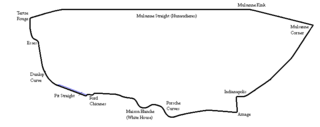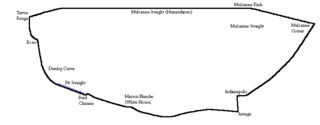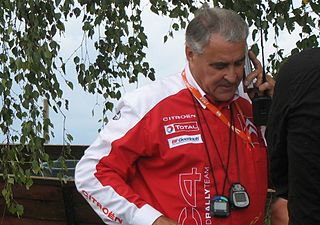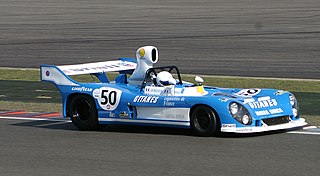
The Porsche 935 is a race car that was developed and manufactured by German automaker Porsche. Introduced in 1976 as the factory racing version of the 911 (930) Turbo and prepared for FIA-Group 5 rules, it was an evolution of the Carrera RSR 2.1 turbo prototype, the second place overall finisher in the 1974 24 Hours of Le Mans.

Didier Joseph Louis Pironi was a French racing driver and offshore powerboat racer, who competed in Formula One from 1978 to 1982. Pironi was runner-up in the Formula One World Drivers' Championship in 1982 with Ferrari, and won three Grands Prix across five seasons. In endurance racing, Pironi won the 24 Hours of Le Mans in 1978 with Renault.

Rolf Johann Stommelen was a German racing driver, who competed in Formula One from 1969 to 1978. In endurance racing, Stommelen was a four-time winner of the 24 Hours of Daytona with Porsche.

The 1980 24 Hours of Le Mans was the 48th Grand Prix of Endurance, and took place on 14 and 15 June 1980. It was the seventh round of both the World Championship for Makes and World Challenge for Endurance Drivers. With neither the Porsche nor Renault works teams contesting the big Group 6 sports-cars for outright victory, it left the prospects open for a privateer victory from Joest, Rondeau or De Cadenet, or from Group 5 again, if they were to fail. The wet weather throughout the race further added to the uncertainty, reducing the advantage of the more powerful cars.

The 1979 24 Hours of Le Mans was the 47th Grand Prix of Endurance, and took place on 9 and 10 June 1979. With no other major works cars this year, the Porsche team were the strong favourites to win. Their competition would be from Cosworth-powered Mirages and Rondeaus and a swarm of Group 5 and IMSA-class Porsche 935s. The other big talking point was the presence of Hollywood actor Paul Newman, driving for Dick Barbour Racing.

The 1978 24 Hours of Le Mans was the 46th Grand Prix of Endurance, and took place on 10 and 11 June 1978. In many ways it was a continuation of the race from the year before – the two main protagonists would be the very evenly-matched works teams of Alpine-Renault and Porsche, with four cars each. The race was not valid for any championship.

The 1977 24 Hours of Le Mans was the 45th Grand Prix of Endurance, and took place on 11 and 12 June 1977. The second year of the FIA Group 5 and Group 6 regulations, it produced an exciting race right up to the end. Porsche had withdrawn from the Group 6 Championship, citing a lack of broad competition. Renault, before their move into Formula 1, decided to put its main racing focus for the year onto Le Mans. The two works teams were the pre-race favourites.

The 1976 24 Hours of Le Mans was the 44th Grand Prix of Endurance, and took place on 12 and 13 June 1976. This year the FIA introduced its new Group 5 and Group 6 regulations and the race was now open to nine distinct classes, although it was still not part of the World Championship seasons. Porsche introduced its new models, the 936 in Group 6, the 935 in Group 5 and the 934 in Group 4. In response, BMW had its modified 3.0 CSL in Group 5. It was the year that turbos arrived in considerable numbers, with over a dozen turbocharged entries, led by the Renault Alpine A442. It saw the arrival of French prototype manufacturers Jean Rondeau and Gérard Welter in a new GTP class and a first-time invitation to American IMSA and NASCAR entries.

The 1975 24 Hours of Le Mans was the 43rd Grand Prix of Endurance, and took place on 14 and 15 June 1975. Colloquially called the “Le Mans Economy Run”, stringent refuelling regulations were put in place. Unable to match the requisite 7mpg fuel economy the manufacturer teams from Ferrari, Alfa Romeo withdrew and Matra had retired from the sport at the end of 1974. Therefore, this only left Gulf and Ligier as front-running works-teams.

The 1974 24 Hours of Le Mans was the 42nd Grand Prix of Endurance, and took place on 15 and 16 June 1974. It was the fifth round of the 1974 World Championship for Makes. After Alfa Romeo had won the first race of the season at Monza, it had been Matra all the way and they came to Le Mans as firm favourites for a third consecutive outright victory, especially after Alfa Romeo withdrew its cars just before raceweek.

The 1973 24 Hours of Le Mans was the 41st Grand Prix of Endurance and took place on 9 and 10 June 1973. It was the eighth round of the 1973 World Championship of Makes.

The 1972 24 Hours of Le Mans was a motor race staged at the Circuit de la Sarthe, Le Mans, France on 10 and 11 June 1972. It was the 40th running of the 24 Hours of Le Mans and the ninth race of the 1972 World Championship for Makes.

The 1971 24 Hours of Le Mans was the 39th Grand Prix of Endurance, and took place on 12 and 13 June 1971. It was the ninth round of the 1971 International Championship for Makes.

The 1969 24 Hours of Le Mans was a motor race staged at the Circuit de la Sarthe, Le Mans, France on 14 and 15 June 1969. It was the 37th Grand Prix of Endurance and was the eighth round of the 1969 International Championship for Makes. The race was open to Group 6 Prototype Sports Cars, Group 4 Sports Cars and Group 3 Grand Touring Cars.
The 1968 24 Hours of Le Mans was the 36th Grand Prix of Endurance, and took place on 28 and 29 September 1968 on the Circuit de la Sarthe, in Le Mans, France.

The 1967 24 Hours of Le Mans was the 35th Grand Prix of Endurance, and took place on 10 and 11 June 1967. It was also the seventh round of the 1967 World Sportscar Championship.

Guy Fréquelin is a French former rally and sports car driver.
The CH-Type was a 90° V6 engine developed by Renault-Gordini for Renault's autosport activities. This François Castaing design was the predecessor of the famous EF series.

The Matra-Simca MS670 was a Group 5 prototype race car introduced in 1972 for the World Championship for Makes. The MS670 replaced the previous Matra-Simca MS660C.

The Alpine A441 is a 2-liter Group 5 sports prototype racing car built by French company Alpine and co-developed by Renault to compete in the 1974 European 2 Liter Sports Car Championship. Designed by French engineer and racing driver André de Cortanze, the four A441s, entered as works cars and each driven by a French driver, won every race in the 1974 competition, taking the Constructors' Championship, with driver Alain Serpaggi taking the Drivers' Championship.
















